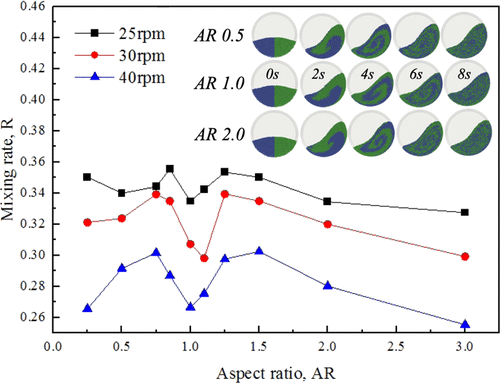当前位置:
X-MOL 学术
›
Ind. Eng. Chem. Res.
›
论文详情
Our official English website, www.x-mol.net, welcomes your feedback! (Note: you will need to create a separate account there.)
A Discrete Element Method Study of Monodisperse Mixing of Ellipsoidal Particles in a Rotating Drum
Industrial & Engineering Chemistry Research ( IF 4.2 ) Pub Date : 2020-06-10 , DOI: 10.1021/acs.iecr.9b06623 Siyuan He 1 , Jieqing Gan 1 , David Pinson 2 , Aibing Yu 1 , Zongyan Zhou 1
Industrial & Engineering Chemistry Research ( IF 4.2 ) Pub Date : 2020-06-10 , DOI: 10.1021/acs.iecr.9b06623 Siyuan He 1 , Jieqing Gan 1 , David Pinson 2 , Aibing Yu 1 , Zongyan Zhou 1
Affiliation

|
Rotating drums are widely used in the industry for mixing, milling, coating, and drying processes. In the past decades, mixing of granular materials in rotating drums has been extensively investigated, but most of the studies are based on spherical particles. Particle shape has a significant effect on the flow behavior and thus mixing performance, but studies and understanding are still limited. In this work, discrete element method is employed to study the radial mixing of ellipsoids in a rotating drum. The effects of rotation speed and aspect ratio of ellipsoids on mixing quality and rate are investigated, and the underlying mechanisms are further developed. The results show that mixing index increases rapidly over time for both spheres and ellipsoids. Particles with various shapes of ellipsoids can reach well-mixed states after sufficient revolutions. The increase in rotation speed decreases the mixing rate for both spheres and ellipsoids. Generally, ellipsoids exhibit a higher mixing rate when the rotational speed ranges between 25 and 40 rpm. At 40 rpm, as the aspect ratio of ellipsoids deviates from 1.0, the mixing rate increases significantly and achieves the maximum when the aspect ratio is 0.75 or 1.5. A further increase in particle non-sphericity incurs a decrease in mixing rate. The increase in the deviation of aspect ratio from 1.0 contributes to stronger “slipping” of particles relative to the drum wall. Compared with ellipsoids, spheres have stronger diffusive mixing and weaker convective mixing in rolling or cascading regimes.
中文翻译:

转鼓中椭球形颗粒单分散混合的离散元方法研究
旋转鼓在工业中广泛用于混合,研磨,涂布和干燥过程。在过去的几十年中,已经广泛地研究了旋转鼓中颗粒材料的混合,但是大多数研究都是基于球形颗粒。颗粒形状对流动行为和混合性能都有重要影响,但研究和理解仍然有限。在这项工作中,采用离散元法研究旋转鼓中椭球的径向混合。研究了椭球体的转速和纵横比对混合质量和混合速率的影响,并进一步发展了潜在的机理。结果表明,球体和椭球体的混合指数均随时间快速增加。经过足够的旋转,具有各种形状的椭球的粒子可以达到充分混合的状态。旋转速度的增加会降低球体和椭球体的混合速度。通常,当转速在25到40 rpm之间时,椭球显示出更高的混合速率。在40 rpm时,随着椭球体的长宽比偏离1.0,混合速率会显着增加,并在长宽比为0.75或1.5时达到最大值。颗粒非球形度的进一步增加导致混合速率的降低。长宽比与1.0的偏差增加会导致粒子相对于鼓壁更强的“打滑”。与椭球相比,球体在滚动或级联状态下具有更强的扩散混合和较弱的对流混合。旋转速度的增加会降低球体和椭球体的混合速度。通常,当转速在25到40 rpm之间时,椭球显示出更高的混合速率。在40 rpm时,随着椭球体的长宽比偏离1.0,混合速率会显着增加,并在长宽比为0.75或1.5时达到最大值。颗粒非球形度的进一步增加导致混合速率的降低。长宽比与1.0的偏差增加会导致粒子相对于鼓壁更强的“打滑”。与椭球相比,球在滚动或级联状态下具有更强的扩散混合和较弱的对流混合。旋转速度的增加会降低球体和椭球体的混合速度。通常,当转速在25到40 rpm之间时,椭球显示出更高的混合速率。在40 rpm时,随着椭球体的长宽比偏离1.0,混合速率会显着增加,并在长宽比为0.75或1.5时达到最大值。颗粒非球形度的进一步增加导致混合速率的降低。长宽比与1.0的偏差增加会导致粒子相对于鼓壁更强的“打滑”。与椭球相比,球体在滚动或级联状态下具有更强的扩散混合和较弱的对流混合。当椭圆形的长宽比偏离1.0时,当长宽比为0.75或1.5时,混合速率会显着增加并达到最大值。颗粒非球形度的进一步增加导致混合速率的降低。长宽比与1.0的偏差增加会导致粒子相对于鼓壁更强的“打滑”。与椭球相比,球体在滚动或级联状态下具有更强的扩散混合和较弱的对流混合。当椭圆形的长宽比偏离1.0时,当长宽比为0.75或1.5时,混合速率会显着增加并达到最大值。颗粒非球形度的进一步增加导致混合速率的降低。长宽比与1.0的偏差增加会导致粒子相对于鼓壁更强的“打滑”。与椭球相比,球体在滚动或级联状态下具有更强的扩散混合和较弱的对流混合。
更新日期:2020-07-08
中文翻译:

转鼓中椭球形颗粒单分散混合的离散元方法研究
旋转鼓在工业中广泛用于混合,研磨,涂布和干燥过程。在过去的几十年中,已经广泛地研究了旋转鼓中颗粒材料的混合,但是大多数研究都是基于球形颗粒。颗粒形状对流动行为和混合性能都有重要影响,但研究和理解仍然有限。在这项工作中,采用离散元法研究旋转鼓中椭球的径向混合。研究了椭球体的转速和纵横比对混合质量和混合速率的影响,并进一步发展了潜在的机理。结果表明,球体和椭球体的混合指数均随时间快速增加。经过足够的旋转,具有各种形状的椭球的粒子可以达到充分混合的状态。旋转速度的增加会降低球体和椭球体的混合速度。通常,当转速在25到40 rpm之间时,椭球显示出更高的混合速率。在40 rpm时,随着椭球体的长宽比偏离1.0,混合速率会显着增加,并在长宽比为0.75或1.5时达到最大值。颗粒非球形度的进一步增加导致混合速率的降低。长宽比与1.0的偏差增加会导致粒子相对于鼓壁更强的“打滑”。与椭球相比,球体在滚动或级联状态下具有更强的扩散混合和较弱的对流混合。旋转速度的增加会降低球体和椭球体的混合速度。通常,当转速在25到40 rpm之间时,椭球显示出更高的混合速率。在40 rpm时,随着椭球体的长宽比偏离1.0,混合速率会显着增加,并在长宽比为0.75或1.5时达到最大值。颗粒非球形度的进一步增加导致混合速率的降低。长宽比与1.0的偏差增加会导致粒子相对于鼓壁更强的“打滑”。与椭球相比,球在滚动或级联状态下具有更强的扩散混合和较弱的对流混合。旋转速度的增加会降低球体和椭球体的混合速度。通常,当转速在25到40 rpm之间时,椭球显示出更高的混合速率。在40 rpm时,随着椭球体的长宽比偏离1.0,混合速率会显着增加,并在长宽比为0.75或1.5时达到最大值。颗粒非球形度的进一步增加导致混合速率的降低。长宽比与1.0的偏差增加会导致粒子相对于鼓壁更强的“打滑”。与椭球相比,球体在滚动或级联状态下具有更强的扩散混合和较弱的对流混合。当椭圆形的长宽比偏离1.0时,当长宽比为0.75或1.5时,混合速率会显着增加并达到最大值。颗粒非球形度的进一步增加导致混合速率的降低。长宽比与1.0的偏差增加会导致粒子相对于鼓壁更强的“打滑”。与椭球相比,球体在滚动或级联状态下具有更强的扩散混合和较弱的对流混合。当椭圆形的长宽比偏离1.0时,当长宽比为0.75或1.5时,混合速率会显着增加并达到最大值。颗粒非球形度的进一步增加导致混合速率的降低。长宽比与1.0的偏差增加会导致粒子相对于鼓壁更强的“打滑”。与椭球相比,球体在滚动或级联状态下具有更强的扩散混合和较弱的对流混合。


























 京公网安备 11010802027423号
京公网安备 11010802027423号